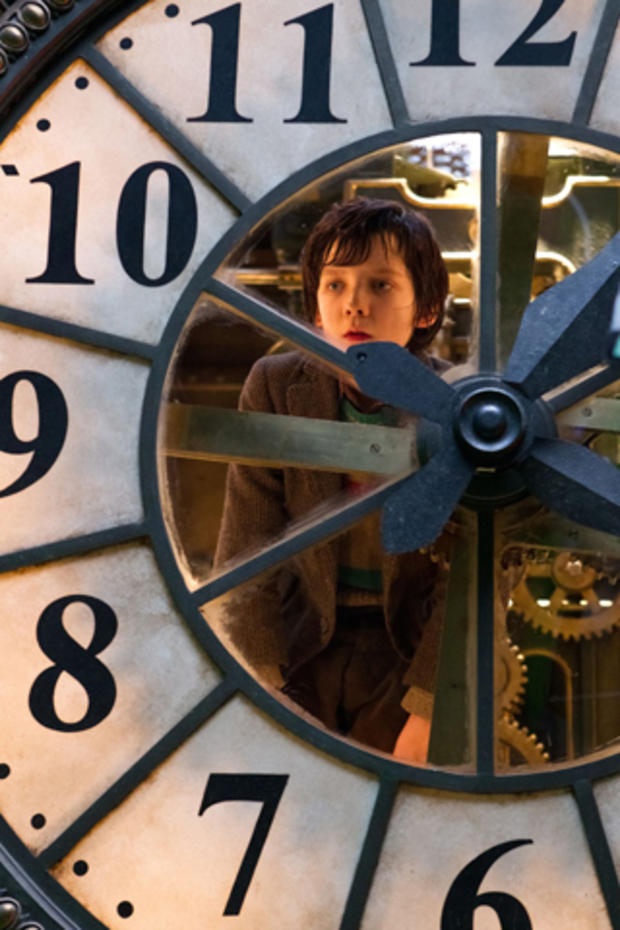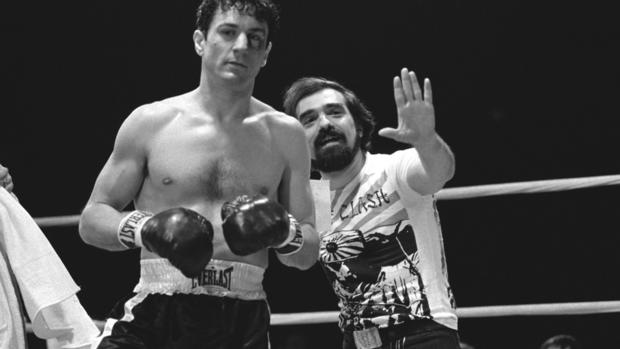Martin Scorsese on "Hugo": A very personal film
With Oscar Night exactly four weeks away . . . we're GOING HOLLYWOOD for these next few Sundays. We begin this morning with director Martin Scorsese, nominated for "Hugo," a picture unlike any he's done before. How his movie came to be is the story he tells Lesley Stahl of "60 Minutes":
Welcome to Hollywood East: Martin Scorsese's Manhattan office, where he edits his films, and screens old favorites. It's decorated with posters of works by such directors as Jacques Tourneur.
It's a wall-to-wall shrine to the greats of the past
"Yeah, I think for me it's, like, just trying to stay in touch with that initial creative impulse and say, 'Oh I want to do that. I want to do something like that,' the inspiration."
One inspiration, and the subject of "Hugo," is the pioneering film-maker George Melies.
"Melies actually was a magician," said Scorsese. "And so he understood the possibilities of the motion picture camera."
"Hugo," "The Artist" lead this year's Oscar race
"Hugo" is a tribute to Melies. In the film, Scorsese shows us just how the old magician worked his tricks. Melies, who directed more than 500 films between 1896 and 1913, was the inventor of special effects.
"He invented everything, basically, he invented it all," Scorsese said. "And when you see these colored images moving, the way he composed these frames and what he did with the action, it's like looking at illuminated manuscripts moving."
But by the end of World War I, Melies was a forgotten man - reduced to selling wind-up toys in a Paris train station.
The central character of "Hugo" is an orphan who lives in a Paris train station that he rarely leaves, viewing the world from behind a giant clock.
"This is what got me really interested in making the film: the way he's looking through the clock," Scorsese said.
In the film it is "Hugo" who rediscovers Melies and his films. In other words, it's a heartwarming children's movie with a happy ending.
"No stabbings, no shootings, no gunfire, no one gets whacked - is Martin Scorsese going soft on us?" asked Stahl.
"Have I mellowed, in a sense?" laughed Scorsese. "From 'Shutter Island'? The story for me was something that opened up a whole new way of approaching cinema. But primarily, it really is a connection with the children."
A sweet connection with children? Are we talking about Martin Scorsese?
Asa Butterfield and Chloe Moretz, two young actors who star in "Hugo," rattled off the list of Scorsese films their parents wouldn't let them see: "Raging Bull," "Mean Streets," "The Departed," "Taxi Driver," "Goodfellas," "Casino" . . .
At the Golden Globes where he accepted the critics group's Best Director Award for "Hugo," Scorsese explained why he made the film:
"I have to thank my love to my wife Helen, because we have a 12-year-old daughter Francesca, [and] she said to me, 'Why don't you make a film our daughter can see for once?' So we did!"
She was born when he was in his late fifties: "You know, it really is life-changing. I didn't quite understand. It's rediscovering the world through the kids."
This is such a different man from the one we first met in 1996 for a "60 Minutes" profile, when Stahl remarked to him, "Everybody says, 'You want to know Marty Scorsese, go see his movies, then you'll get him.' And your movies are so much about anger!"
"Yeah. Always, always," he replied. "I've been in a bad mood twenty five years!"
Back then he took us to his old New York City neighborhood, where he'd grown up a lonely and sickly child.
As a young boy he was so ill with asthma he spent a lot of time indoors at the movie theater. He couldn't go outside and rough-house with the other kids. He could only watch them from his window.
In "Hugo," the boy hidden in the train station also views the world looking through a window. Stahl suggested he'd made a movie about himself.
"That, I think, was the first connection," he said. "I loved the idea of a young person who's unable to join in, 'cause of me with my asthma and that sort of thing. But I was able to - that third floor front window was sort of like a panoramic image of life" to me.
The window frame was his movie screen, and while he observed life from up there, he began dreaming up films of his own.
"Because of this illness, I really couldn't participate," he said. "I was always observing. I was in it, but at the same time, I really couldn't fully - "
"You were a voyeur?" asked Stahl.
"Yeah, yeah. Like Hugo, yeah."
But Scorsese is ALSO like Melies the magician, who's always experimenting with the latest technologies . . . which is why Scorsese shot "Hugo" in 3-D.
"I wanted to use 3D as another storytelling element," he explained. "The way we're sitting here now is 3D. So, why can't we use that, as we use color, we use sound, we use movement? The way Melies did it, he was inventing it as he went along. And we found ourselves in a similar situation with the 3-D. Because every time you put the camera in place, it was the added element of depth."
He said his initial designs were sometimes confounded: You say, 'Wait a minute. That's too much. No, wait. That's - oh, that's not enough! How about if we push this a little further? What if we do it wider?' That kind of discovery. But you never knew where - it was like a tightrope. Once we started on it, we couldn't go back!"
We were wondering if the changes in Scorsese's personal life - happily married to his fifth wife, Helen; attentive father - have spilled over into his work habits.
"When we interviewed you, you told us that you'd been angry for 25 years," Stahl recalled, "and that you were banging phones, breaking phones."
"I still dislike phones, yeah!"
"You were a raging guy?"
"Yeah, yeah."
"Do you still rage?"
"Yes, I think so. I think so," he said. "But what happens now is, I'll go off in a room. Let me get past this and move on. Figure out, okay, what are the facts? Forget the emotion."
Thelma Schoonmaker has been his editor for nearly 50 years. She edited "Hugo" in 3-D. She's been there when Scorsese has smashed editing machines.
"When he was editing the film would snag and break, and then he would get mad and he would hit the tiny little screen, thick glass, with his hand and break it," Schoonmaker recalled with a laugh, "And so after a while rental companies wouldn't rent to him anymore!"
She's also seen the Scorsese who dotes on his 12-year-old daughter Francesca - perhaps even grooming her for a spot in the family business.
"Every Saturday he screens two films for her," Schoonmaker said, "and he carefully picks them. And I remember once she was sitting with me in the editing room waiting for him, and she just blurted out, 'I love Charlie Chaplin.'
"And I thought, 'Oh my God! Marty couldn't think of anything he would want to hear more!"
Scorsese said he shows his daughter and her friends a movie every weekend.
"In 16 years, as far as I can tell, you have not lost any passion for films, for watching them, making them, talking about them and loving them," Stahl said. He agreed.
So what's next for Martin Scorsese? Well, he's directing and producing HBO's "Boardwalk Empire," and on the big screen, there's an upcoming film about Jesuits in 17th century Japan . . . and a Frank Sinatra biopic.
Maybe, even something for the Internet: "Yes. I would think so. Yeah," he said, but "If YouTube, you mean like a little cat eating milk, drinking milk? No. I'm not gonna do that."
But he sees the web as a place for narrative.
"Oh, yeah. Well, you see, the thing is this: Wherever it can be shown, I'm open to trying that venue. Because right now, we're at a time there's great transformations taking place in communication. The same way as the period of Georges Melies."
For more info:
- "Hugo" (Official movie website)
- "The Invention of Hugo Cabret" by Brian Selznick (author website)


